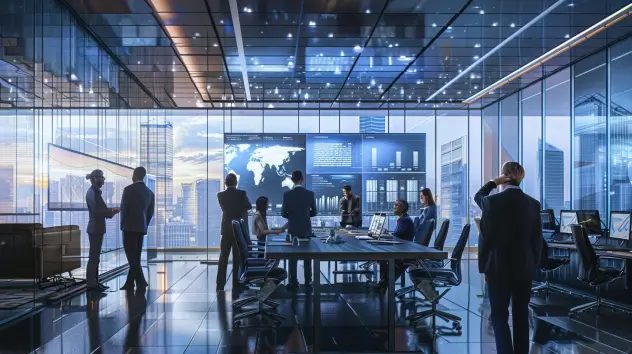Introduction

In today’s fast-paced business world, the clarity of a job description goes beyond a mere list of duties—it’s a cornerstone of organizational success and individual career development. As a seasoned consultant addressing both aspiring project managers and the employers eager to harness their potential, I emphasize the transformative power of well-crafted job descriptions. For candidates, a clear and comprehensive job description serves as a roadmap, outlining not only the expected duties but also the opportunity for personal and professional growth. For employers, these descriptions are pivotal in attracting candidates who are not just qualified but are genuinely the best fit for the role and company culture.
Project MAnager Job description template

This dual perspective approach is central to our discussion. Whether you are drafting your next career move or seeking to fill that vital project management position within your company, understanding these descriptions from both sides of the hiring equation enriches your approach and enhances outcomes.
Project management, as a discipline, is indispensable across various sectors—be it technology, construction, healthcare, or finance. Project managers orchestrate teams, manage resources, and lead initiatives that drive businesses forward. The role’s importance in achieving organizational goals cannot be overstated—it’s about creating order from chaos, aligning projects with strategic objectives, and ensuring that teams operate in a harmonious and efficient manner.
As we navigate through this guide, whether you aim to step into the role of a project manager or you’re crafting the perfect job description to attract one, you’re engaging in a process critical to career and organizational triumph. Let’s embark on this journey together, exploring how a well-defined role opens doors to endless possibilities for both personal advancement and business success. This introduction sets the stage for a comprehensive exploration of the project manager job description, ensuring that each reader is not only informed but also ready to apply this knowledge effectively in their professional lives.
Mastering Project Management: Unveiling the Essential Role of a PM
Understanding the Role of a Project Manager

In the dynamic and ever-evolving landscape of modern business, the role of a project manager is both critical and complex. As you sit here, whether you’re aspiring to become a project manager or you’re an employer looking to hire one, it’s essential to grasp the comprehensive nature of this pivotal position.
Project managers are the architects of order, the champions who turn chaos into clarity by meticulously planning, executing, and closing projects. They ensure that business goals align with technical execution, and they manage the broad spectrum of project needs across various industries. For those of you looking to step into this role or integrate such talent into your organization, understanding these key responsibilities is the first step.
In Technology, project managers spearhead initiatives ranging from software development to cybersecurity implementations. They navigate the rapid pace of technological advancement and shifting user expectations, ensuring projects meet the cutting edge without sacrificing reliability.
In Healthcare, they manage projects that might range from rolling out new patient care technologies to overseeing the construction of healthcare facilities. Each project carries its own set of stringent regulatory compliances and impacts patient care directly, making the stakes exceptionally high.
In Construction, project managers are pivotal in translating blueprints into buildings. They coordinate between architects, engineers, and contractors, ensuring that projects remain compliant with all safety laws and regulations while meeting budget and timeline targets.
In Finance, they might lead projects like system integrations or new financial product launches. Each project requires meticulous attention to regulatory compliance and risk management, balancing innovation with the security of financial assets.
Across these fields, project managers encounter common challenges like scope creep, where project boundaries expand unnoticed over time. They also face resource limitations, which can stall project momentum. And perhaps most critically, they navigate complex stakeholder management dynamics, where differing agendas and expectations can significantly alter project trajectories.
Let me give you an example. Imagine a project manager leading a software upgrade for a global bank. Midway through, new regulatory requirements emerge, expanding the project scope. Simultaneously, key team members are reassigned to another project, slicing resources. The project manager must not only address these challenges but also manage stakeholder expectations across different continents, each with their unique demands and time zones.
Overcoming such challenges is no small feat, yet the rewards are substantial. Effective project management leads to career advancement, high job satisfaction, and the opportunity to make a significant impact on an organization’s strategic goals. This role demands adaptability, strategic thinking, and excellent communication skills, but the payoff is becoming a linchpin in your organization’s success.
As you contemplate your future as a project manager or consider how to integrate one into your team, remember that this role is about more than just keeping projects on track. It’s about envisioning a goal, mobilizing a team, and leading them through the complexities of modern business landscapes to deliver success. Whether you are stepping into this career or seeking someone to fill it, the journey of a project manager is one of continuous learning and adaptation, ensuring that each project not only meets its goals but also drives innovation and improvement within the organization.
For Candidates: How to Interpret a Project Manager Job Description

Welcome to a crucial chapter in your journey toward becoming a successful project manager. As a career coach, my goal today is to help you decode the complexities of job descriptions in the field of project management. By the end of this session, you’ll be equipped not just to understand but to strategically analyze and use this information to advance your career.
Demystifying Key Terms in Job Descriptions
Let’s start by clarifying some of the key terms you often encounter in project manager job descriptions:
Stakeholder Management: This means you’ll be expected to communicate and coordinate with various parties interested in the project—this could be internal teams, external clients, or even regulatory bodies. Daily, this involves updating stakeholders on progress, gathering their requirements, and managing their expectations.
Scope Control: Keeping a project within its planned boundaries. Practically, this involves monitoring the project deliverables and ensuring that the project does not deviate from the agreed-upon features, budget, or deadlines.
Risk Mitigation: This involves identifying potential risks to the project’s timeline, budget, or quality and planning how to minimize these risks. On a day-to-day basis, it could mean anything from scheduling regular review meetings to setting up contingency plans.
Evaluating Job Descriptions
Understanding and evaluating a job description properly can be transformative. Here’s how you can do it:
Align with Career Goals and Values: Look for keywords and phrases that indicate what the company prioritizes. Does the description emphasize innovation and creativity, or does it focus on stability and long-term growth? Ensure these align with what you want from your career.
Company Culture and Growth Opportunities: Pay close attention to the language that hints at company culture—words like ‘fast-paced’, ‘team-focused’, ‘innovative’, can tell you a lot. Look also for mentions of professional development opportunities, such as training programs and career progression paths.
Leveraging Job Descriptions in Applications
With a clear understanding of the job description, you can tailor your applications more effectively:
Resume and Cover Letter Tailoring: Highlight experiences in your resume that directly address the key responsibilities and skills listed in the job description. In your cover letter, speak directly to the job’s needs by describing how your previous successes prepare you to meet their specific challenges.
Interview Preparation: Use the job description as a study guide. Prepare to discuss how your skills align with the job requirements. Be ready to share examples from your past work that demonstrate you have the experience and capabilities they are seeking.
Jumpstart Your Project Manager Career with C9Staff! Get Hired.

For Employers: Crafting an Effective Project Manager Job

Step 1: Drafting a Clear and Comprehensive Job Description
The foundation of attracting the right candidates starts with clarity and completeness in your job descriptions. Each description should begin with a concise job title and overview that reflects the core responsibilities of the role. It’s essential to outline specific responsibilities clearly, distinguishing between daily tasks and broader project goals. Remember, a well-drafted job description serves as a mirror of the role, reflecting its true nature and scope.
Step 2: Specifying Qualifications, Skills, and Cultural Fit
Identifying and specifying the necessary qualifications and skills is crucial. Include required educational backgrounds, essential skills, and preferred experiences that align with the role’s demands. However, equally important is defining the cultural fit. For instance, if your organization values innovation and continuous improvement, highlight the need for candidates who demonstrate adaptability and a proactive mindset.
Consider this scenario: A tech startup focused on sustainable solutions emphasizes not only technical expertise in project management tools but also a passion for sustainability and innovation. By mentioning these in the job description, the company attracts candidates who are not only capable but also genuinely interested in the organization’s mission.
Step 3: Using the Job Description to Communicate Company Values and Career Growth
A job description is a powerful tool for communicating your company’s values and the potential for career growth. Clearly state how the role contributes to the company’s goals and how it fits into the larger organizational structure. Articulate the career pathways and development opportunities available to the successful candidate. This not only enhances your employer branding but also attracts candidates looking for roles that offer long-term growth and development.
For example, by including statements like, “You will lead projects that directly contribute to our mission of expanding renewable energy use worldwide, with opportunities for professional development in global project management and leadership,” you not only define the role’s impact but also its growth trajectory.
Project MAnager Job description template

Project Management Mastery: Top 5 Skills You Need in 2024
Key Skills and Qualifications for Project Managers

Core Skills for Every Project Manager
Leadership: The cornerstone of project management, leadership involves more than directing tasks; it includes inspiring your team, resolving conflicts, and making critical decisions under pressure. Strong leadership ensures that the project team remains motivated and cohesive, even when faced with challenges.
Effective Communication: Every project manager must be able to clearly convey ideas, expectations, and issues to a variety of stakeholders. This skill is crucial for managing expectations, soliciting stakeholder feedback, and ensuring transparency throughout the project lifecycle.
Risk Management: Identifying, analyzing, and responding to project risks is a fundamental requirement for a project manager. Effective risk management means you can mitigate potential problems before they impact the project’s timeline or quality.
Enhancing Qualifications with Certifications
To further enhance your qualifications, consider obtaining certifications that validate your knowledge and skills:
PMP (Project Management Professional): Offered by the Project Management Institute (PMI), the PMP is one of the most respected certifications in the field. It demonstrates your ability to manage the triple constraints of time, cost, and scope of a project.
CAPM (Certified Associate in Project Management): Also from PMI, this certification is ideal for those with less project management experience but who wish to improve their credibility and project management skills.
Agile Certifications: Given the increasing adoption of agile methodologies in project management, certifications like Certified ScrumMaster (CSM) or SAFe Agilist (SA) can be particularly beneficial in industries such as IT and software development.
Skill Variations Across Industries
The relevance of specific skills and qualifications can vary significantly by industry:
In Construction: A deep understanding of safety regulations and quality control standards is essential. Project managers in this industry often require additional certification in safety management and local building codes.
In IT: Technical skills are paramount. Familiarity with software development life cycles, continuous integration, and continuous deployment processes are crucial. Technical project managers might also benefit from having hands-on experience in coding or system architecture.
Hire Quality Project Managers at 70% Less with C9Staff

Career Path and Advancement for Project Managers

Career Progression in Project Management
The journey of a project manager often begins at an entry-level position such as a Project Coordinator or Assistant Project Manager. In these roles, you’ll be tasked with supporting project leads, managing documentation, and learning the ropes of project planning and stakeholder communication. This foundation is crucial as it prepares you for the complexities ahead.
Advancing to a Project Manager role, you’ll take full responsibility for managing projects from inception to completion. This includes budgeting, timeline setting, overseeing cross-functional teams, and ensuring project deliverables align with organizational goals. Success in this role is marked by your ability to lead teams and manage resources efficiently.
As you continue to excel, you might step into a Senior Project Manager or Program Manager role, where strategic thinking and leadership become paramount. Here, your focus shifts to managing multiple projects or large-scale programs, making decisions that will have a broader impact on the organization’s direction and success.
The Power of Education and Certification
Continuing education and obtaining certifications are pivotal in climbing the project management ladder. Certifications such as PMP (Project Management Professional), PRINCE2 (Projects in Controlled Environments), and Agile/Scrum credentials serve as benchmarks of your expertise and commitment to the field. These certifications not only enhance your resume but also equip you with methodologies and practices that improve project outcomes.
PMP certification, recognized globally, signifies that you understand the language and framework of project management on an international scale.
PRINCE2 offers a process-based approach, ideal for those looking to manage projects within a structured framework.
Agile/Scrum certifications highlight your ability to work in fast-paced, iterative project environments that require flexibility and adaptability.
Embracing these learning opportunities not only propels your career forward but also keeps you competitive in a field that is continuously evolving.
Future Outlook and Evolving Skills
The landscape of project management is rapidly transforming with technological advancements. Digital project management tools, for instance, are no longer optional but essential. Knowledge of platforms like Asana, Trello, or Jira will enhance your efficiency and effectiveness.
Moreover, the integration of AI and machine learning into project management is not just futuristic—it’s happening now. These technologies are beginning to automate tasks such as risk assessment and resource allocation, which means you’ll need to stay ahead by understanding and leveraging these tools.
The Power of Well-Crafted Job Descriptions
Hearing from candidates like Lucy, a project manager in renewable energy, sheds light on this dynamic. She shared, “The job description at my current company stood out because it detailed their commitment to innovation and growth within the green tech space, which aligned perfectly with my professional aspirations and values. It wasn’t just about the role but about how the role contributes to the world.”
If you’re seeking expert assistance to source, recruit, hire, train, manage, and deploy the ideal Project Manager for your organization, C9Staff is ready to provide tailored support. Click the link below to schedule a free exploratory call with one of our dedicated account managers. During this call, we will carefully listen to your specific needs and freely endorse potential candidates, helping you to evaluate the best talent available at competitive prices. Don’t miss this opportunity to refine your recruitment strategy and enhance your team with top-tier project management professionals.
Hire Quality Project Managers at 70% Less with C9Staff

Conclusion

As we wrap up today’s extensive exploration into the world of project management, let’s revisit the crucial insights and strategies we’ve uncovered. Whether you’re stepping into the realm of project management for the first time or you’re looking to enhance your organization’s talent acquisition, remember: the foundation of success lies in the clarity and precision of your job descriptions.
The Role of Job Descriptions: Job descriptions do more than list responsibilities—they bridge the gap between a project manager’s expertise and an organization’s needs. They serve as a crucial tool for ensuring that there is a mutual understanding and alignment of goals and expectations. For candidates, a detailed description helps assess the fit and potential for long-term career growth. For employers, it’s about attracting the right talent who not only meet the technical requirements but also embrace the company culture and contribute to long-term objectives.
The Need for Continuous Learning: Project management is not a static field. It’s dynamic, with new methodologies, technologies, and best practices continually reshaping the landscape. I urge all of you—candidates and employers alike—to commit to lifelong learning. Stay current with certifications, such as PMP, Agile, or Scrum. Embrace new technologies that streamline project tracking and team collaboration. By staying informed and adaptable, you ensure that you remain competitive and effective in an ever-evolving industry.
Now, I encourage each of you to take this knowledge beyond today’s session. Engage with the community. Share your experiences and insights on social media. Comment on this article with your stories or the challenges you face. Your contributions are invaluable—they enrich discussions, deepen collective knowledge, and foster a community of practice that supports growth and innovation in project management.
Remember, your journey in project management is one of continuous growth and interaction. Whether you are seeking to advance your own career or to recruit and develop top-tier talent for your organization, every step you take is a move towards mastering the art and science of project management.
As you move forward, equipped with the insights from today, you’re not just following a career path or filling a role. You’re setting the stage for transformative projects that can define the success of businesses and careers alike. Let’s continue this conversation, learn from each other, and build a thriving network of project management professionals ready to face the challenges of tomorrow.




